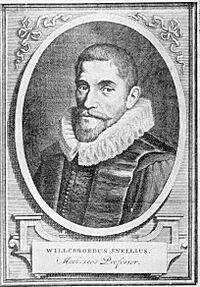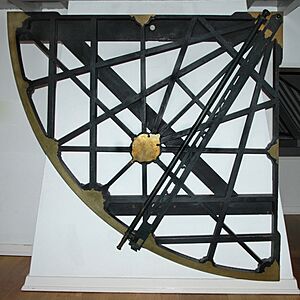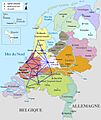Willebrord Snellius facts for kids
Quick facts for kids
Willebrord Snellius
|
|
|---|---|

Willebrord Snel van Royen (1580–1626)
|
|
| Born | 13 June 1580 |
| Died | 30 October 1626 (aged 46) |
| Nationality | Dutch |
| Alma mater | University of Leiden |
| Known for | Snell's law Snellius' triangulation Snellius–Pothenot problem |
| Scientific career | |
| Fields | Astronomy and mathematics |
| Institutions | University of Leiden |
| Academic advisors | Ludolph van Ceulen Rudolph Snellius |
| Notable students | Jacobus Golius |
Willebrord Snellius (born Willebrord Snel van Royen) was a famous Dutch scientist who lived from 1580 to 1626. He was a brilliant astronomer, who studies stars and planets, and a mathematician, who works with numbers and shapes. Most people know him as Snell. He is especially famous for discovering the law of light refraction, which is now called Snell's law. This law explains how light bends when it passes from one material to another, like from air to water.
A lunar crater on the Moon is named after him, called Snellius. Also, the Royal Netherlands Navy has named three of its survey ships after him, including one that is still used today.
Contents
About Willebrord Snellius
Willebrord Snellius was born in Leiden, a city in the Netherlands. In 1613, he took over his father's job as a professor of mathematics at the University of Leiden. His father, Rudolph Snel van Royen, was also a well-known mathematician.
Measuring the Earth: Snellius' Triangulation
In 1615, Snellius became one of the first people in modern times to try and measure the size of the Earth using a method called triangulation. This was a very big and important experiment! He was inspired by an ancient Greek scholar named Eratosthenes, who measured the Earth's size over 1,800 years before him.
Snellius had help from two of his students and friends in different cities. He wrote about his methods in a book called The terrae Ambitus vera quantitate (1617). In this book, he was called "The Dutch Eratosthenes" because of his amazing work.
He estimated that one degree of latitude (a way to measure distance north or south on Earth) was about 107.37 kilometers. If you multiply this by 360 (the number of degrees around the Earth), you get a total circumference of about 38,653 kilometers. The actual distance around the Earth is 40,075 kilometers, so Snellius's measurement was very close, only off by about 3.5%!
To get his results, Snellius measured distances between tall points in the western and southwestern parts of the Netherlands. He used triangulation, which involves creating triangles to figure out distances. To do this accurately, he used a special tool called a quadrant. This tool helped him measure angles very precisely. You can still see this quadrant in the Museum Boerhaave in Leiden today.
Snellius used 14 different points, mostly church spires, because they were the tallest buildings around at that time. He made 53 different measurements in total. His calculations also helped solve a math problem now known as the Snellius–Pothenot problem.
Mathematics and Physics Discoveries
Snellius was also a very important mathematician. He found a new way to calculate π, which is a special number used in circles. His method was the first big improvement in calculating pi since ancient times!
In 1621, he made his most famous discovery: the law of refraction. This law explains how light bends when it passes from one material to another, like when light goes from air into water or glass. This discovery is now known as Snell's law.
Other Important Works
Besides his book on measuring the Earth, Snellius wrote other important books. These included Cyclometricus, de circuli dimensione (1621), which was about measuring circles, and Tiphys Batavus (1624). He also helped publish a book called Coeli et siderum in eo errantium observationes Hassiacae (1618), which contained astronomical observations. A book about trigonometry (the study of triangles) called Doctrina triangulorum was published a year after he passed away.
His Passing
Snellius died in Leiden in October 1626, when he was 46 years old. He passed away from an illness. His grave can be found in the Pieterskerk, Leiden church.
Honours
A Snellius Glacier in Antarctica is named after Willebrord Snellius, honoring his contributions to science.
Images for kids
-
Commemorative plaque on Snellius' house in Leiden
See also
 In Spanish: Willebrord Snel van Royen para niños
In Spanish: Willebrord Snel van Royen para niños






